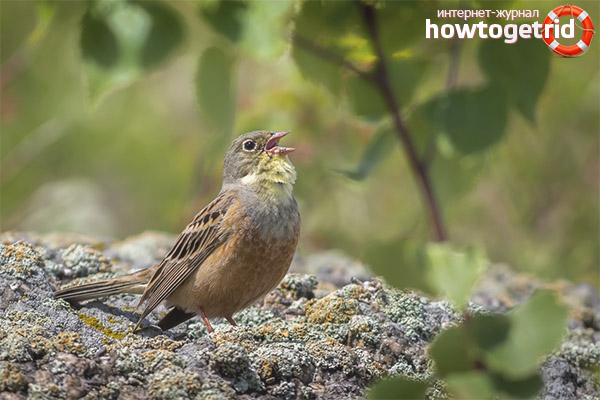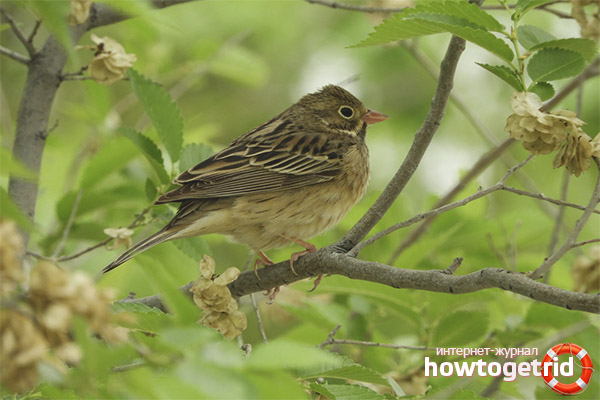The content of the article
Garden oatmeal is a very interesting representative of the order Passeriformes and the oatmeal family. These are small birds, the size of which reaches no more than 17 centimeters in length. The wingspan can reach up to 30 centimeters. The body weight of oatmeal also reaches about 30 grams.
Oatmeal is a fairly common bird, especially often they can be found in rural areas. Here they prefer to settle near the plantings of various crops.
Oatmeal Appearance
Bunting is very compact. You can distinguish them from other birds by their bright color and voice. Around the eyes of these birds there are whitish rings. In general, the head is colored olive in the same way as the breast area. The beak is pinkish in color. Also on the head you can distinguish peculiar yellow "antennae", which turn into the same yellow neck. The belly of oatmeal has a chestnut color.
You can distinguish males and females by the color of plumage. In female representatives, the pattern on the head is less pronounced, and in general the plumage is less bright, consists mainly of brownish shades. In addition, male and female buntings also have different voices and songs. The male usually screams very loudly, making the sound of a Tew Türrr. In females, the cry is slightly different; they usually pronounce “cyc-cyc”, and more quietly than males.
Where are oatmeal common?
After wintering, these birds return in the spring, approximately in late April or early May. The males are the first to return from the warm lands, after which they begin to spend time behind their songs. After a few days of singing, oatmeal begin to equip their nests. I must say that these birds settle exclusively in pairs, and often they are located at a very great distance from each other. In rare cases when this is necessary, oatmeal can settle in very sweaty colonies.
As materials for the construction of the nest, leaves of various cereal crops, stems, thin roots, and also dry leaves are used. In general, the litter is solid and rather thick.
Where do they live?
Basically, oatmeal is chosen for living open spaces, on which there are separately located shrubs and trees. You can also meet these birds in the forest-steppes, often for life they choose the hillsides, well-lit by the sun, and also the foot of the mountains. In rare cases, oatmeal settles directly in orchards or in vineyards, in which for a long time no one has been working and collecting fruits. Also, these birds are attracted by river valleys, fields sown with cereal crops, as well as meadows intended for pastures.
Oatmeal Propagation

The period of nesting and laying of eggs in oatmeal falls on May-June. As a rule, the nest settles down directly on the ground or on small elevations.In such a nest, the female oatmeal lays up to 5 eggs, which have an interesting color. In general, they are grayish in color, in addition you can notice dark spots, as well as stripes that resemble worms in shape. The hatching process takes only 12 days. After that, the chicks stay in the nest for another 12-13 days, and then stand on the wing and fly out of the dwelling. In a year, the female makes one laying of eggs; in some southern regions, sometimes females can make even two laying.
Already at the end of June, one can find the first young broods of these birds, usually in river valleys and other water bodies. Already in the fall, by the end of September, the chicks, together with their parents, go to warmer climes for wintering.
The songs from the garden oatmeal are similar to the voice of an ordinary oatmeal, however, there are some differences. In the garden variety, the song consists of 4 sounds, at the end one or two short trills. One can distinguish it from ordinary oatmeal by the absence of the characteristic “sound of vesia” in the song.
What do oatmeal eat?
The diet of these birds is based on the seeds of various plants. During the period when the female feeds the chicks, insects and various bugs are mainly consumed.
Species protection
Garden buntings today belong to protected species of birds, in the red book they are assigned 3 categories. It is worth noting that their numbers are falling every season. This is due primarily to the fact that the habitats of these birds are significantly reduced. In addition, the problem also lies in the economic activities of people, as more and more pesticides are used. We must not forget about poaching, which is also common today. Also, inappropriate conditions in the wintering areas of these birds often become the reason for the reduction in the number of species. The average lifespan of oatmeal is about 6 years.
Another reason why the population of these birds is declining is that oatmeal is considered a delicacy in many countries and is eaten. In order to fatten the oatmeal, they are caught, and then closed in a dark room with millet. In birds, the instinct of continuous absorption of food awakens as a result of being in a dark room. After the oatmeal reaches the desired mass, they are killed by drowning in Armagnac. After that, the bird as a whole is fried and served in the same way on the table. With the absorption of oatmeal, the French have an ancient custom. After serving, cover the dish and head with a napkin to feel the full brightness of the aroma. Such a ritual is sometimes interpreted as the desire to hide the meal from the eyes of God, which, of course, is no more than irony. At one time, large quantities of pickled oatmeal were exported from Cyprus.
To date, garden oatmeal is not well understood, therefore, there is no set of measures to preserve this species.
Oatmeal Relative Birds
Bright relatives of garden oatmeal is red-billed oatmeal. It differs in color of plumage from its relative. The head, as well as the upper part of the breast, are covered with gray feathers. These birds mainly nest in the southeastern part of European territories, as well as in the Middle East. Sometimes birds find themselves in Italy, in our country it is impossible to meet them.
Video: garden oatmeal (Emberiza hortulana)











Submit